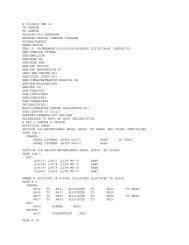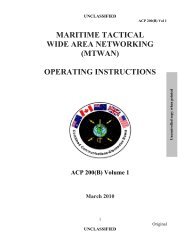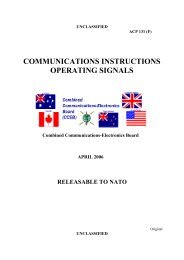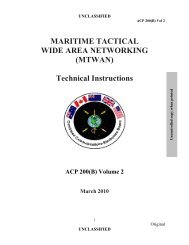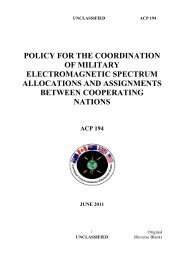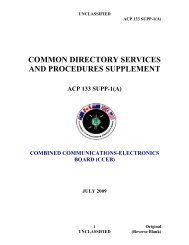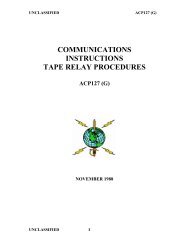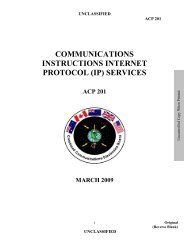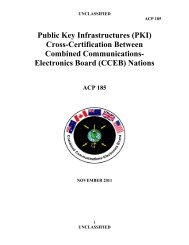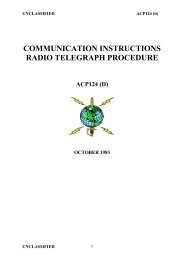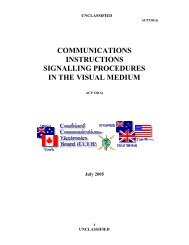ground routing protocol for use with automatic link establishment
ground routing protocol for use with automatic link establishment
ground routing protocol for use with automatic link establishment
Create successful ePaper yourself
Turn your PDF publications into a flip-book with our unique Google optimized e-Paper software.
UNCLASSIFIED<br />
ACP193<br />
(a) MS-ALE incorporates coding techniques to detect and correct transmission errors<br />
ca<strong>use</strong>d by HF channel disturbances. However, not all transmission errors can be corrected<br />
this way and received AMD messages are not guaranteed to be error-free. Consequently, a<br />
received HF-GRP message may contain errors – in which case the message needs to be<br />
rejected (a re-send would then need to be instigated by the mobile radio operator).<br />
(b) A received AMD text message is identified as a HF-GRP message by the character<br />
combination ‘CCCC’ (field 1) at the start of the message. If the message does not start <strong>with</strong><br />
this character combination then it can be considered that the message is not intended <strong>for</strong><br />
<strong>automatic</strong> <strong>ground</strong> <strong>routing</strong> and can be interpreted according to local operating procedures. It<br />
must also be recognised that a HF-GRP message received <strong>with</strong> errors in field 1 will also fit<br />
this category so additional checks will be needed if it is required to identify this case.<br />
(c) A received HF-GRP message must be rejected if it does not comply <strong>with</strong> the<br />
<strong>for</strong>matting rules specified under the <strong>protocol</strong> description, contains an unrecognised or<br />
disallowed ‘Call Dial Code’ value or, in the case of self-verified calls, does not pass the call<br />
verification test.<br />
(d) In detail, a received HF-GRP message must be rejected if any of the following<br />
conditions apply.<br />
(1) There are characters in the message that are not in Table 2-1 (NB the ‘,’<br />
(comma) is also an allowable character).<br />
(2) There are characters in a message field that are invalid <strong>for</strong> that particular field.<br />
(3) The length of any of the message fields is invalid.<br />
(4) Characters are present in the message after field 6 (apart from any AMD call<br />
‘space’ padding characters).<br />
(5) The call dial code is unrecognised or disallowed by the receiving HF <strong>ground</strong><br />
station.<br />
(6) Additionally, <strong>for</strong> ‘Self-verified direct calls’ and ‘Self-verified programmed<br />
calls’ only, the valid ‘Call Verification’ character must be determined via the<br />
checksum calculation using the received characters in fields 2, 3 and 4. If this<br />
character does not match the ‘Call Verification’ character in the received message,<br />
then the message must be rejected.<br />
(e) If a message is rejected then no attempt is made to route the <strong>link</strong> over the <strong>ground</strong><br />
network. Following the rejection of a message it is recommended that the receiving HF<br />
<strong>ground</strong> station instigates the <strong>automatic</strong> termination of the ALE <strong>link</strong> to the mobile. The mobile<br />
may then re-attempt a <strong>link</strong>.<br />
(f) This procedure <strong>for</strong> identifying and rejecting erroneous HF-GRP messages is intended<br />
to prevent calls being routed to the wrong location due to radio transmission errors or<br />
message compilation errors. Checks 1 to 5 above will trap most erroneous messages.<br />
However, if the HF-GRP is widely deployed and the set of valid call dial codes is large then<br />
high reliability against incorrect <strong>routing</strong> requires the <strong>use</strong> of the self-verified call <strong>for</strong>mat to<br />
provide increased protection.<br />
3-2<br />
UNCLASSIFIED



